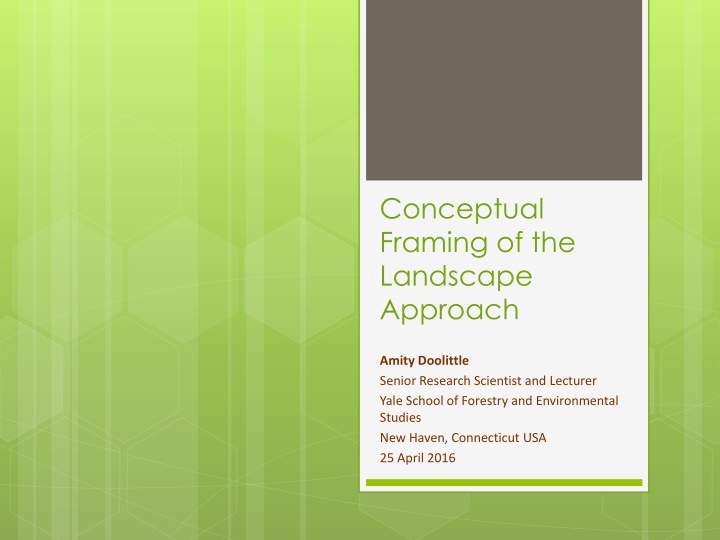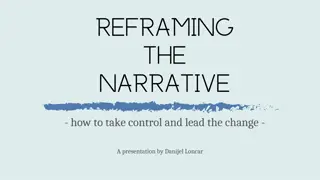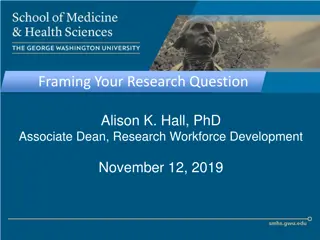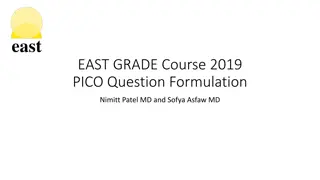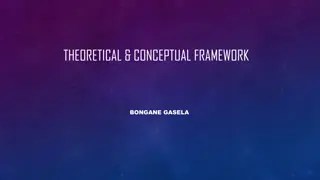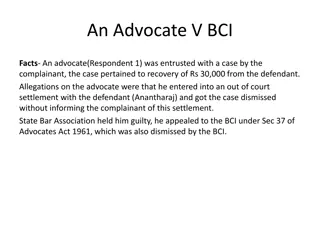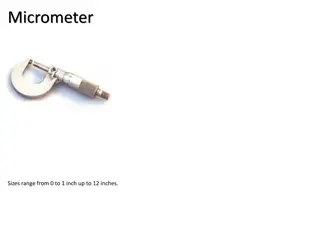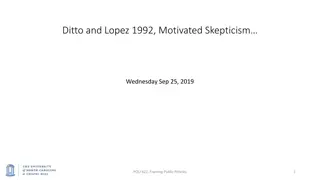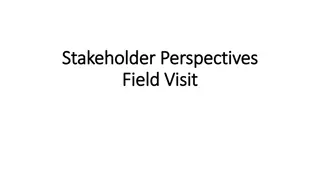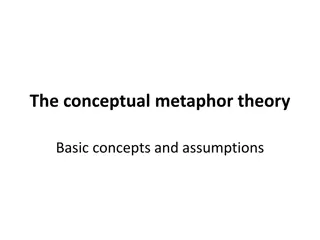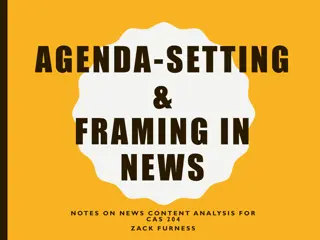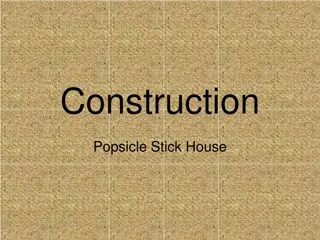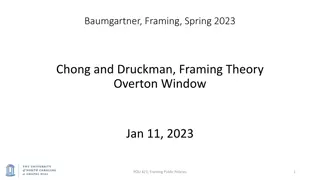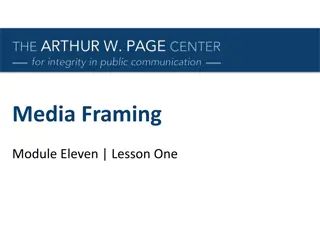Conceptual Framing of Landscape Approach
A comprehensive exploration defining landscape, the landscape approach, and its scale. It delves into shared understanding, goals of land use dialogue, social learning, adaptive management, and challenges. The landscape is viewed as a socio-ecological system influenced by various processes. The landscape approach aims to reconcile competing objectives, address trade-offs, enhance management, ensure local needs, move away from unsustainable practices, and foster collaboration with industry for improved governance and resource conservation.
Uploaded on Mar 12, 2025 | 1 Views
Download Presentation

Please find below an Image/Link to download the presentation.
The content on the website is provided AS IS for your information and personal use only. It may not be sold, licensed, or shared on other websites without obtaining consent from the author.If you encounter any issues during the download, it is possible that the publisher has removed the file from their server.
You are allowed to download the files provided on this website for personal or commercial use, subject to the condition that they are used lawfully. All files are the property of their respective owners.
The content on the website is provided AS IS for your information and personal use only. It may not be sold, licensed, or shared on other websites without obtaining consent from the author.
E N D
Presentation Transcript
Conceptual Framing of the Landscape Approach Amity Doolittle Senior Research Scientist and Lecturer Yale School of Forestry and Environmental Studies New Haven, Connecticut USA 25 April 2016
Outline 1. Define landscape 2. Define landscape approach 3. Define scale of landscape approach 1. Starting Point for Shared Understanding 2. Goals of Land Use Dialogue 1. Social Learning and Adaptive Management 2. Challenges http://mongabay- images.s3.amazonaws.com
Landscape A socio-ecological system which includes - natural and human-modified ecosystems - influenced by distinct ecological, historical, political, economic and cultural processes and activities https://en.wikipedia.org/wiki/Rice_Terraces_of_the_Philippine_Cordilleras
Landscape approach Conceptual approach to understanding land use that recognizes there are often competing interests of different stakeholders Source: http://peoplefoodandnature.org/blog/understanding-the-relationship-between-forests-and-agriculture-the-need-for-a-landscape-approach/
Landscape approach 1. Aims to reconcile competing social, economic and environmental objectives through national and local level actions http://www.desdemonadespair.net/2011/09/brazils- atlantic-forest-stores-less.html - equitably address land- use trade-offs - enhance carbon- intensive landscape management
Landscape approach 2. Aims to ensure the realization of local level needs and action (i.e. the interests of different stakeholders) 3. Moves away from the often unsustainable sectoral approach to land management http://inr.oregonstate.edu/
Landscape approach 4. Encourages collaboration with industry within global commodity supply chains to improved land use governance - reducing carbon emissions and pressure on natural resources http://dinheirorural.com.br/secao/agrone gocios/novas-garras-da-klabin
Scale of landscape approach Is defined by local stakeholders: - small enough to maintain a degree of manageability - large enough to be able to deliver multiple functions to stakeholders with different interests. Source: http://www.ridingbrazil.com/sj-farm-stays.html
Scale of landscape approach The boundaries are set by stakeholders and may correspond to: - natural boundaries - distinct land features - socially defined areas - indigenous territories - jurisdictional and administrative boundaries
Starting Point Shared understanding of various stakeholder perspectives - Conflicts over resources in landscapes are exacerbated by misunderstanding of the perspectives and motivations of other stakeholders management or claims on resources http://rsb.org/activities-and-projects/smallholder-program-in-brazil/
Starting Point Shared understanding of: Spatial relationships within the landscape between different land uses and land users
Starting Point Shared understanding of institutional or policy context - Include an understanding the relationships and power dynamics between institutions Source: http://www.slideshare.net/CIFOR/assessing-future-impacts-of-land-use-policies-in-brazil
Starting point A shared understanding of the appropriate level of cooperation among stakeholders Information sharing - one-way flow of information, often down top Engagement - a two-way flow of information and exchange of views Collaboration - joint activities, where the initiator, often the government, retains decision- making authority Joint decision-making - collaboration with shared control over decisions Empowerment - control over decision-making, resources and activities is transferred to other stakeholders.
Goals of Land Use Dialogue Conservation goals - How can we conserve, maintain and restore native biodiversity and critical ecosystem services Productiongoals - Provide sustainable production of food, fuel, fiber, forests, and fodder Livelihood goals - Sustain and enhance the livelihoods and wellbeing of people
Goals of Land Use Dialogue 1. Engage all relevant stakeholders Including those involved in external processes and plans - Identifying hidden actors, such as absentee landowners - Identify land users who have not traditionally been engage in land use decision-making process - Foster discussion between the various stakeholders
Goals of Land Use Dialogue 2. Gather knowledge for enabling - responsible land use, sustainable development - maintenance or restoration of ecosystem functions Source: http://www.scielo.br/scielo.php?script=sci_arttext&pid=S1415-43662015000100070
Goals of Land Use Dialogue 3. Support improved land use governance and inclusive development and responsive to climate change - Set objectives and develop local ideas and activities that integrate public and private interests
Goals of Land Use Dialogue 4. Identify level of openness by different stakeholder groups to engage in collaborative landscapes management Develop support from corporate initiatives within global commodity supply -
Goals of Land Use Dialogue 5. Develop an understanding of the relationship between forest and agricultural sectors ecosystem functions http://www.worldbank.org/en/news/infographic/2016/03/16/forests-create-jobs-infographic
Goals of Land Use Dialogue 6. Address the challenges of competing demands for land and water use - intensification of forestry and farming - conservation and restoration of ecosystem services http://www.natgeocreative.com/photography/1372586
Social learning and adaptive management Focus on idea generation, implementation, monitoring and reassessing Is a new paradigm for collaboration possible? - Support the translation and diffusion of new knowledge and practices
Social learning and adaptive management Stimulate adaptive social learning by - involving actors at multiple levels local to global - international actors amplify the impact of national organizations and institutions
Challenges How can we move beyond the conceptual level towards managing at the landscape scale for multiple objectives? http://sdgs.peoplefoodandnature.org/
Challenges 1. How can we integrate public and private needs into the landscape and foster public-private partnerships? 2. How can we reconcile the sometimes-competing objectives of economic development and environmental sustainability? 3. How do we move across institutional boundaries that traditionally hinder integration? 4. How do we measure success (or failure) and define whether a landscape is being managed sustainably ?
Sources The Sustainable Landscapes Books http://www.commonland.com/_doc/GCPLittleSustainableLBDEC15_228876964.pdf Sayer, Jeffrey, Terry Sunderland, Jaboury Ghazoul, Jean-Laurent Pfund, Douglas Sheil, Erik Meijaard, Michelle Venter et al. "Ten principles for a landscape approach to reconciling agriculture, conservation, and other competing land uses." Proceedings of the National Academy of Sciences110, no. 21 (2013): 8349-8356. DeFries, R., and C. Rosenzweig. "Toward a whole-landscape approach for sustainable land use in the tropics." Proceedings of the National Academy of Sciences 107, no. 46 (2010): 19627- 19632. Frost, Peter, Bruce Campbell, Gabriel Medina, and Leonard Usongo. "Landscape-scale approaches for integrated natural resource management in tropical forest landscapes." Ecology and Society 11, no. 2 (2006): Articel-30. Cumming, Graeme S., Per Olsson, F. S. Chapin III, and C. S. Holling. "Resilience, experimentation, and scale mismatches in social-ecological landscapes." Landscape Ecology 28, no. 6 (2013): 1139-1150. Outcome Statement of the 2015 Global Landscapes Forum http://www.landscapes.org/publication/2015-global-landscapes-forum-outcome-statement/ Landscapes Measures Center http://landscapemeasures.info/?p=74 Assessing future impacts of land use policies in Brazil. Presentation at the Global Landscapes Forum 2015, in Paris, France alongside COP21 http://www.slideshare.net/CIFOR/assessing- future-impacts-of-land-use-policies-in-brazil
